| 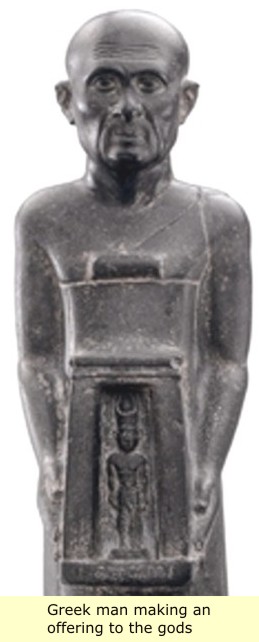 |  |
Ancient Egypt under Greek and Roman RuleFrom: New York University - unofficial on-line content The Importance of Periods of Foreign Domination to the Study of Egypt Overall If one wishes to understand how the Egyptians conceived of themselves (or, as many would put it, how the Egyptians constructed their identity), one of the most productive ways of doing so would be to examine the interactions between Egyptians and foreigners - the Egyptians’ view of things when their land was under foreign control. For one thing, there are several examples of foreign rulers attempting to present themselves as part of the ancient pharaonic tradition. During times of foreign rule the Egyptians frequently adopted certain means to maintain and emphasize the distinctness of their cultural heritage. Both attempts, those of foreigners to acquire an Egyptian identity as well as those of the Egyptians to maintain it, offer some telling insights into what being Egyptian was. Although we cannot be certain, it is likely that in these efforts of both parties, we are shown behavior which probably closely paralleled events in other, less documented eras of Egyptian history, such as the Hyksos Period. Some General Characteristics of Greek Rule in Egypt The Ptolemies were quite unlike other foreigners who had ruled Egypt in several respects. Most importantly, they ruled within Egypt. One of the best phrases for understanding the nature of their government’s relationship with the country on which they imposed their rule is that “the Ptolemies used Egypt.” (By contrast, it is fair to say that “the Romans abused Egypt.”) The Greeks could use Egypt because they came upon a well developed country in respect to its economic, intellectual, and political life. These factors were in force to an extent which was unparalleled anywhere else within the Hellenistic world where the Greeks had placed themselves to rule over indigenous populations. In the case of Egypt, the Ptolemies found themselves in control of a highly sophisticated ancient civilization and administration, not a group of cloddish barbarians. The Egyptians had as high a level of culture as the Greeks, but it was quite different from theirs. The fact that the Egyptians stuck to their ways annoyed and puzzled the Greeks and gave the Egyptians the reputation as being stubborn, ornery, and, for lack of a better word, reversed. On the latter point, we should listen to Herodotos describing his impression of Egypt as he visited it (Book 2, 35): “Just as the climate that the Egyptians have is entirely their own and different from anyone else’s, and their river has a nature quite different from other rivers, so, in fact, the most of what they have made their habits and their customs are the exact opposite of other folks’. Among them the women run the market and shops, while the men, indoors, weave; and, in this weaving, while other people push the woof upwards, the Egyptians push it down. The men carry burdens on their heads, the women carry theirs on their shoulders. The women urinate standing upright, while the men do it squatting. The people ease nature’s needs in the houses but eat outdoors in the streets; their explanation of this is that what is shameful but necessary should be done in secret, but what is not shameful should be done openly. No woman is dedicated to any god, male or female, but men to all gods and goddesses. There is no obligation on sons to maintain their parents if they are unwilling, but an absolute necessity lies on the daughters to do so, whether they will or not.” This is typical of Herodotos in that it is a mixture of fact and fiction, all of which was heavily colored by his desire always to tell a good story. To this observation we should also add the remarks of Alan Lloyd, an Egyptologist who has done what still remains as the best study of Herodotos’ description of Egypt from an Egyptological point of view. Lloyd, not incidentally, is the author of the relevant chapter in our textbook. Lloyd’s ultimate conclusion is that Herodotos, “presents a view of Egypt’s past which shows no genuine understanding of Egyptian history. Everything has been uncompromisingly customized for Greek consumption and cast unequivocally into a Greek mold.” The last statement here also summarizes much of the Greek point of view when dealing with Egypt administratively . . . at least, that is what they tried at first. The Ptolemaic regime may have modernized several aspects of the Egyptian economy, particularly with the introduction of coinage that made transactions much more efficient, yet we should also bear in mind that Egypt already had had a successful agricultural system in place for several millennia when the Greeks appeared. The history of Ptolemaic Egypt is not a unity; it changed with the course of time, particularly in the Ptolemies’ governance of their Egyptian subjects. In the end run it was not possible to exclude the indigenous population and at the same time to compete successfully against the other nations of the Mediterranean. It is also important to remember that the Greeks were never evenly distributed throughout Egypt, especially at the beginning of Ptolemaic rule. The two cultures existed side-by-side, but they seldom truly mixed in any meaningful fashion. It was possible for an Egyptian to Hellenize, but the process was rather formidable, since it essentially required abandoning the native culture almost totally. To a great extent in the past this had been true of foreigners entering Egypt who had wished to adopt the Egyptian way of life. Language and dress, rather than any notions of race or ethnicity, were the means by which one became Egyptian (or Greek). In general, one does not really see anything quite like what we would consider as racism until perhaps Roman times. If nothing else, the willingness of Greek men to marry Egyptian women – not merely to have them as concubines – speaks loudly to that point. As Ritner puts it, (“Cross-cultural Interaction,” p. 289), “Clear evidence of any sort of racial or cultural chauvinism is exceedingly rare for the Ptolemaic period.” Attitudes of cultural superiority, of course, were another matter, but this feeling of superiority was by no means necessarily racist in its nature. In both societies there was a great degree of snobbishness towards outsiders. The very word “barbarian” was derived from a Greek word that originally meant “a non-Greek speaker.” The Ionian Greeks, for example, were well aware that their Persian overlords whom they describe as “barbarians” possessed a very high level of cuture. Clannishness of both Greeks and Egyptians certainly existed, but this is to be expected given the cultural and language differences in the towns where they lived side-by-side. Certainly one of the most telling indicators in this matter was the prevalence of intermarriage. Intermarriage was even more common out in the countryside and among the military where there was not as much of a wealth and status difference between the Egyptians and Greeks. In all fairness, it should be pointed out that in almost every case the documentation shows a Greek or Macedonian man marrying an Egyptian woman and seldom an Egyptian man marrying a Greek woman. The law seems to have been that the children inherited their ethnic identification through the father. A Greek woman marrying an Egyptian man would probably be losing her status (“marrying down”). However, in the end run, Egyptian culture was always more tolerant in its outlook than the Greek. For another critical aspect of making a cross-cultural transformation in Ptolemaic society, we should consider a word borrowed from contemporary Greek society, i.e. “barbarian.” As pointed out above, although today the word means a brutish, uncultured, and unlettered foreigner, in Ptolemaic times the term primarily meant “one who did not speak the Greek language.” It is important also to remember the significance of the term for this period – the Hellenistic Period, lit. the Greek-speaking Period. Here again, both the Greek and Egyptian cultures were in agreement that in order for one to enter their respective societies, one had to speak their language. “Church” and “State” in Ptolemaic Egypt These entities two were never separate in pharaonic Ancient Egypt, so we shouldn’t expect too much difference in this respect during the Ptolemaic period. Nevertheless, the Greeks tended to keep church and state more separate, except, strikingly enough, in Ptolemaic Egypt. These rulers strongly promoted a cult of the divine king, even while the monarch was still alive. This cult, furthermore, was aimed primarily at the Greek part of the population. By Alexander’s time there were three politically relevant groups in Egypt: the military, the bureaucracy and the clergy. Of these, the “church,” i.e. the temple system and the associated priesthoods, was the trickiest aspect of the culture to deal with. The Egyptian temples were the main repositories of the native cultured and the primary site of native elite intellectual life. The Greek administration recognized this from the beginning and acted accordingly. The idea would be to co-opt this power to the benefit of the Ptolemaic kings. Above all, this aid to the “church” took the form of fiscal relief and exemptions from various regulations, and most important of all temple building along the requisite financial support. It should be borne in mind that for a great deal of the Ptolemaic regime, the only means for advancement for many native Egyptians were through the temple and priestly administrations. The phyle system of rotating priestly activity, which had the practical result of the priests spending most of their time in cultivating their lands for their own support, was a major factor in the economy. This meant that the priests were by no means separate from the daily concerns of their fellow Egyptians. Instead men who were nominally priests moved among the rest of the population as regular citizens, especially in the economic sense. In addition, this mean that for the practical matters of most of their daily life, Egyptian priests were literally neighbors to the Greeks living on the military cleruchies (land allotments), who were military men by their formal occupation, but farmers for most practical concerns. These two important groups knew each other well. The combination of their priestly and agricultural duties meant that the Egyptian priests’ role as the guardians of the traditional culture was quite fitting. The priesthood may have been something of a hereditary occupation at this time. Egyptian culture required that there should be textual support for the legitimacy of the Ptolemaic kings in the temples. At the same time, these temples were the chief locations for the support of the native Egyptian culture. The Greek rulers needed the Egyptians to put the correct formulations on their legitimacy. Some Egyptian cults had quite a bit of success among the Greeks, especially that of Osiris and Isis. The cult of Serapis represents an interesting attempt on the part of the Greek ruling house to integrate into the Egyptian belief system, but it remained a primarily Greek-oriented cult. The Serapis cult was not, however, an attempt to integrate the two religious spheres as is sometimes stated. Serapis was not worshipped under that name among the Egyptians. Also striking was the deification of the Ptolemy kings and queens even while they were alive, something relatively uncommon among the Egyptians. Ptolemy I by-name “Sotor (the Savior),” eventually took on a religious designation as well. The royal cult was a most important aspect of Ptolemaic kingship. It is hard, however, to judge how this transferred into genuine religious feeling among the Greeks, let alone the Egyptians. The use of the Egyptian gods for oracles was still quite common among the native populace, another factor in maintaining the influence of the old religion. In this, one can say that their gods were still very much involved in the daily life of the native population. From the native point of view, legitimacy also had to be transferred into the practical political sphere. The Egyptians had to identify with the aspirations, domestic and foreign, of the Ptolemies. The temples were a particularly good medium for the spreading of royalist propaganda, as had been the case in pharaonic times. Counter-Greek propaganda existed in literary forms that was produced and broadcast primarily through the temples. The “Demotic Chronicle” and the “Potters Prophecy” reveal that there were opposing opinions among the Egyptian intellectuals to the ruling power. Of course, with these oracles’ predictions of eventual disaster to befall the foreign interlopers, such documents expressed a type of wishful thinking prevalent among the native population that had to be placated. At the same time, the Nectanebos Legend, stating that Alexander was an offshoot of the last legitimate native king is significant, perhaps expressing a desire among the native population to see in the new rulers a tie with the last of the independent Egyptian monarchs. Other Aspects of Greek-Egyptian Relationships The appearance of the Greeks in Egypt was in effect a social revolution in a different form. Egypt was now dominated by a new elite. Before the arrival of the Greeks, furthermore, status in society was determined largely by one’s function, i.e. occupational caste. The country was not merely divided now between rich and poor, for members of either group could become wealthy or poor. Originally, the Greeks came as mercenaries who were settled as colonists, the so-called cleruchies (kleruchoi, from the term kleroi “allotments”). Generally speaking, this land grant system was not normally the practice with mercenaries elsewhere in the ancient world who often went home after their enlistments were over, so the kleruchoi were something of a Ptolemaic innovation. As time went on, other Greeks entered Egypt in considerable numbers through immigration, but never amounting to a substantial proportion of the overall population. Nevertheless, these Greeks now became the dominant voice in the historical record. After all, the literacy rate in their own language was higher among the Greeks than it was among the Egyptians. Outside of Alexandria and its immediate vicinity, the major Greek settlements were at Naukratis, Philadelphia (in the Fayyum), and Ptolemais (near Dendera in Upper Egypt). These settlements were unlike the Greeks’ former pattern of colonization through independent cities, since these places had none of the same degree of self-government found in the colonies outside of Egypt. The local governments, the politeumata, in many ways were formed largely as a means of preserving (Greek) national identity more than anything else. The alphabetized Greek language, considerably easier to learn for the purposes of reading and writing, was to have a profound influence on the profile of literacy in the country. To enter the bureaucracy one had to Hellenize, i.e. adopt the Greek language. There are cases in which the officials would label someone who could read Egyptian (but not Greek) as being illiterate -- a rather telling attitude! Obviously, under circumstances such as these, an ambitious young Egyptian would have to learn Greek if he wished to be successful in this society and its administration. Significantly, despite the Greek attitude towards the Egyptian language, it was possible to deposit documents in Demotic for legal purposes during the Ptolemaic period, provided the matter concerned Egyptian parties alone; an abstract of the document in Greek was frequently appended. The Romans discontinued this practice of limited acceptance of the Demotic dialect—a major blow to the survival of the ancient language. In addition, there seem to have been a great number of bilingual people in the land, but these men and women for the most part were in the middle and upper strata of society. In respect to written language, however, it was the flow towards Greek that overwhelmingly predominated. Greeks were not apt to learn how to read and write Egyptian. Increasingly the native language was supported only by the priestly class. Consequently, one never sees Greeks playing a role in Egyptian cult, which was ultimately quite language oriented, especially because it was the main repository of Egyptian culture. At the same time, however, certain Egyptian deities enjoyed considerable popularity among the Greeks, whereas Greek religion never found much support among the Egyptians. This does not mean that the native religion did not receive subsidies from the royal house—quite to the contrary, as remarked previously. The Jews were another prominent group of foreigners in the land, located mostly in Alexandria, but could be found on the local level as well. On the whole, the Ptolemies seem to have had a “philo-Semitic” policy. The Jews did not mix as well with the Egyptians, however. The Greeks intermarried extensively with the Egyptians. Discrimination was seldom on any basis which one might call racial by today’s standards. At least among the Egyptians, marriage was considered to be a strictly civil matter, much like other civil contracts and removed from any interference from civil and religious authorities. Language and customs determined who one was in the eyes of society. Obviously, clothing also played an important role here. The native legal system was allowed to exist, but only where it did not conflict with the dominant Greek interests. Mixed courts even existed to a limited extent. Again, this was a practice which the Romans were to end. As mentioned above, citizenship from the Greek point of view was hard to come by and strictly controlled. People were associated with ‘tribes’ and other local units (demes) that had Greek names. On the local level Greek males belonged to assemblies, gymnasia, acted as magistrates and members of local councils, but the overall practice was not really democratic in the sense of the older Greek tradition. Often one had to show Greek ancestry to enter into this combination of educational and fraternal system. Wealth and privilege were tied to governmental obligations as well. This distinctive set-up was allowed to persist into the Roman era. Native Revolts and Resistance There were several of native uprisings of varying severity during the Ptolemaic regime. These colored heavily the Greeks’ relations with their Egyptian subjects, forcing them towards increasing accommodation if they wished to survive the pressures from the outside. During the Third Syrian war (246-241) in Euergetes’ reign (Ptolemy III Euergetes “Benefactor” I 246-222), there were disturbances caused by the economic hardships arising from the need to support a long war. The resulting unrest was severe enough to force the king’s return to Egypt. Thebes was the focal point of one serious revolt in 207/6, and seemed to have housed two native “pharaohs” for a while, perhaps with Nubian backing. Dissatisfaction was rife well up into the 190s in this region of Egypt. As I may have pointed out before, this uprising may have all been a result of the prominent role of the Egyptian troops at the battle of Raphia in 217 BC and the failure for the Ptolemies to throw enough sops in the direction of the Egyptians afterwards. This intermittent series of uprisings were perhaps the most worrisome of all and Ptolemy V’s Rosetta (or: Memphis) Decree was probably a direct result. Ptolemy V (Ptolemy V Epiphanes “God-manifest” 204-180) was crowned at Memphis according to the ancient Egyptian custom as well, even though he continued to rule from Alexandria. Other revolts broke out in the 160s then again 130s as well. Later on we have literary evidence of resistance to Egyptian rule, such as the so-called Oracle of the Potter, a Demotic text predicting the end of the reign of Alexandria and the return to Memphis of the (Egyptian) ruling house, i.e. the restoration of native rule. Thus, both pressure within and pressure without forced the Ptolemies to bring Egyptians more fully into both the military and the governing apparatus. The focal point for most of the Egyptian resistance to Greek rule was centered on the temples, which were the focal points of Egyptian cultural activity. Cultural Disasters under Ptolemy VIII and later For all its great reputation as the intellectual capital of the Hellenistic world, Alexandria did not maintain that position for ever. An enormous blow to its reputation came in 145 BCE when Ptolemy VIII (Ptolemy VIII Euergetes II Physcon 145-116) expelled nearly all the leading intellectual lights of his capital city in a fit of unexplained pique. He removed Aristarchos of Samothrace, a man of world-wide scholarly reputation, as the head of the famous Library, replacing him with a low-level military officer, so as to deepen the insult. The Museum and its scholars suffered similarly. As a consequence, even when the city was to regain some of its intellectual prestige in later years, it never quite recovered from this needless blow. During the Mitradaic war, many writers, artists, and thinkers from all over the region fled to Alexandria to avoid this clash between Rome and the Pontic kingdom. Rome, now an intellectual center in its own right, also benefited from this flight. Nearly a hundred years after this great banishment, Julius Caesar appeared in Alexandria in the summer of 48 BCE. Among other things, he attempted to settle the dispute between Cleopatra (VII) and her brother Ptolemy XII, by establishing a joint rule between them. He had a love affair with Cleopatra from which sprang their child, Casareon (Ptolemy XIV). Unfortunately, the struggle between the various parties did not end, and in 47 BCE the Alexandrians rose up against Caesar, who at one point barely escaped with his life. During this revolt (or riot) the great Library supposedly caught fire and burnt to the ground. Other versions of the events, however, say that it was only a warehouse in which copies of works for export were stored that was destroyed and the Library survived only to be destroyed later. Caesar later defeated the Egyptians, killing Ptolemy XIII in the process. He handed over the reigns of the country to Cleopatra and Ptolemy XIV to rule jointly and, returning home, left three legions in Egypt to maintain Roman control. The country became a Roman province between 47-44. Caesar left before his son was born The Economy This was by far the most successful aspect of the Ptolemaic regime. It was still primarily agriculturally based, although in Alexandria foreign trade and finance were to play a considerable role in the life of that city. Trade guilds, something which we know of in small numbers in pharaonic times, became more important at this time. Royal patronage was important in this respect. It is important to bear in mind that even as the Ptolemies were declining as a military and political power (and as Rome’s influence was growing), Egypt’s position as a major economic power remained virtually unchanged. Most labor was paid for in kind rather than coinage. Outside of Alexandria probably only around one-fifth to one-sixth of the population lived in what might be considered an urban environment, but still, this was a much higher percentage than had been the case during pharaonic times. Alexandria, always a special case, grew to an immense size—it has been estimated that in the early days of Roman control Alexandria may have had over a million inhabitants. Villages were quite common, but could never grow much in size due to the constraints of the environment. Plagues could wipe out a large segment of any town. Out in the countryside the peasantry lived by subsistence farming, but real, abject poverty was rare. Consequently, Egypt may have enjoyed something of a population boom during the Ptolemaic Period. On occasion when the burdens of taxation, etc. became too great, large segments of the farming population would abandon their plots and flee into the nearby desert – anachoreisis, as the phenomenon was called. This phenomenon increased under the Romans. The main impact of the Greeks was the successful implementation of coinage, and therefore, money. This did not however end the barter or exchange aspect of the economy, but it did greatly increase the role of markets in the system. Taxes, certainly, continued to be paid in kind, since the peasantry by-and-large participated only marginally in the monetized segment of the economy. These people, furthermore, no longer needed to be located near the river to participate in the economy. Fairly soon on, the coinage became “closed,” i.e. foreign currency was not allowed and had to be exchanged for the Ptolemaic coinage. People were aware of any fooling around with the currency, so debasement or the like could not be done by the ruling house with impunity. The government may have taken about 30% of the gross national product of the country in taxes. Additional governmental influence on the economy came in the form of regulations. We have no idea of how the rate of taxation compared with the practices of the ancient pharaonic regime. |
 Ptolemy II (Philadelphus)
Ptolemy II (Philadelphus)282-246 B.C.
Ptolemy II Philadelphus, which means 'Brother/Sister-loving', was the second ruler of the Ptolemaic Dynasty. He was married to his full sister Arsinoe II. His greatest contribution to the world is that it was he, who desiring to augment his library in Alexandria, Commissioned a translation of the Hebrew Scriptures into Greek.
Ptolemy wrote to the chief priest "Eleazar" in Jerusalem, and arranged for six translators from each of the twelve tribes of Israel to come to Alexandria. These translators were known as "The seventy-two" (altered in a few later versions to seventy or seventy-five). The reason for so many translators, was so that the many translations could be compared to each other for accuracy.
The translators are said to have arrived in Egypt to Ptolemy's gracious hospitality, and translated the Pentateuch: [The first five books of the Hebrew Scriptures], believed by some to have been written by Moses. The work was completed in seventy-two days? Although opinions differ, most agree on 282 B.C, as the time of completion. Thus the SEPTUAGINT, {the original Bible}, derived from the Latin word for "seventy", was written. Of course, all of this is Very Controversial, and opinions do vary.
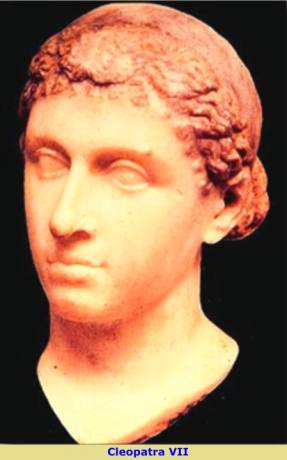 Cleopatra VII
Cleopatra VII
In the springtime of 51 B.C, Ptolemy Auletes died, and left his kingdom to his eighteen year old daughter Cleopatra, and her younger brother Ptolemy XIII, who was twelve at the time. Cleopatra was born in 69 B.C, in Alexandria Egypt. She had two older sisters, Cleopatra VI and Berenice IV, as well as a younger sister, Arsinoe IV. There was two younger brothers as well, Ptolemy XIII and Ptolemy XIV. It is thought that Cleopatra VI may have died as a child, and that Auletes had his daughter Berenice beheaded.
Also upon Ptolemy Auletes death, "Pompey" a Roman leader, was left in charge of the children. During the two centuries that preceded Auletes death, the Greek Ptolemies had been allied with the Romans. Now the Ptolemies' strength was failing, and the Roman Empire was rising. City after city was falling to Roman power, and the Ptolemies could do nothing but create a pacts with them.
Over time, the Romans gained more and more control over Egypt. Tributes had to be paid to keep them away. When Ptolemy Auletes died, the fall of the Dynasty appeared closer and closer. Thus begins the "well known" saga of Cleopatra, Caesar and Mark Antony.
For a chronological history of the Greek Occupation of Egypt, and the saga of Cleopatra, Caesar and Mark Antony, with associated pictures. Click Here >>>
The Romans
With the death of Cleopatra, Egypt passed into Roman hands. And so now, Egypt has a Roman King. It is with the ascension of the Roman emperor Constantine, that a new era begins for Alexandria, as well as for the Empire as a whole. By defeating his co-ruler "Licinius" (Rome had begun the practice of having two rulers, one for the eastern half of the Empire, and one for the western half), Constantine now is sole ruler.He established the eastern capital for the Empire in what is now modern Turkey, in a city called Byzantium, which he renamed Constantinople. (After this city is sacked and taken over by the Ottoman Turks in 1453, it would be renamed Istanbul). The Romans, as the Greeks had earlier done, assume Egyptian customs and regalia, and do their best to drain the country dry. As had happened when the Greeks took control of Egypt, now Romans and those under Roman hegemony have unfettered access to Egypt. Further eroding the population demographic.
Egyptians fared no better under Roman occupation than they had under the Greeks. It was just more of the same, which continues unto today, marginalization into obscurity. With the occupiers now claiming ethnic identity.
Late period Egyptian Inventions
However, even under these difficult circumstances, Egyptians did not loose their inventiveness and genius. In about 60 A.D. the Egyptian "Heron of Alexandria" invented the first "Steam Engine" the steam-powered device called the “Aeolipile”.He also invented the Windwheel (Windmill). The first "Gun" was used by Egyptians against the Moguls in the 1260 battle of Ain Jalute. It would be hundreds of years, before Europeans came to understand these things sufficiently to copy and use them. |
As would be expected, under Greek, and then Roman rule; Egypt would be a tale of three people. The White Greeks or Romans; The "Mixed-Race" Greeks and Romans; (it is unknown how many of these people CAME to Egypt as mixed race people, (Greece and Rome were both mixed race societies at this time); and how many were Egypt "Mixed"; and then the indigenous Black African Egyptians. There can be no doubt that the Black African Egyptians would be in the more difficult position. This is demonstrated by the relative quality of Black African Egyptian tombs, as compared to White and mixed-race tombs of the Graeco-Roman period.
 |
| These two stele are from Kom Abou Billou, the necropolis of the ancient city of Terenouthis. Click here for more stele from Kom Abou Billou >>> |
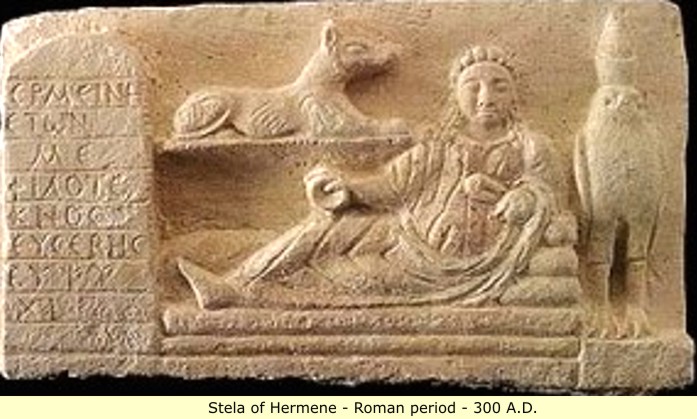 |

Mummy Portraits and Masks From the Greek and Roman Occupation Periods of Egypt
The custom of preserving and immortalizing the deceased through painted art is very ancient, as attested to by ancient Egyptian and Etruscan tomb paintings. Caucasians upon entering Southern Europe and later Egypt, adapted painting as a medium of expression, and added a few wrinkles of their own.No Egyptian tomb paintings are presented in these pages, because all of those available to the public have been repainted. Being ever mindful of the dishonest practices of restorers, it seemed pointless to present material for which there is no confidence.
The genre highlighted here, is mostly painted Mummy Portraits found on Mummies in Roman cemeteries, many from Fayum/Faiyum. They date from approximately 100 B.C. to 250 A.D. Mummy portraits were portraits painted on joined wooden planks, and were placed over the face of the Mummified corpse. The gold facemask of Egyptian tradition was also still used, as well as painted plaster masks and painted linen shrouds. The Christian Copts (Greeks) of Egypt, continued the tradition of painting on wood for many centuries more, but their subject matter was mostly of a religious nature.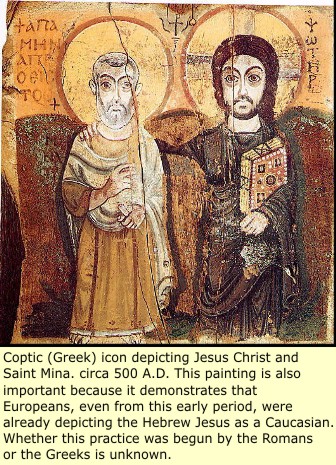

There are about 900 Mummy Portraits excavated so far, of course, because they are two thousand years old, they were all in poor condition when recovered. They of course required the services of restorers to bring them back to a serviceable condition. As is always the case with restorations, some restorers are faithful to the original material, and some restorers are not, choosing instead to follow a personal or group agenda.
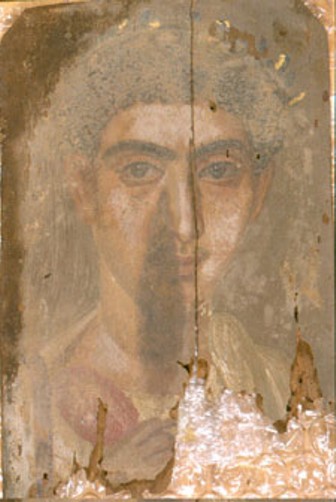

The portraits presented here, run the gambit from the crude to the very beautiful. Whether this represents a gradual mastery of painting by Europeans, the talent or lack of talent of individual artists, or simply restorers taking inappropriate liberties is unknown.

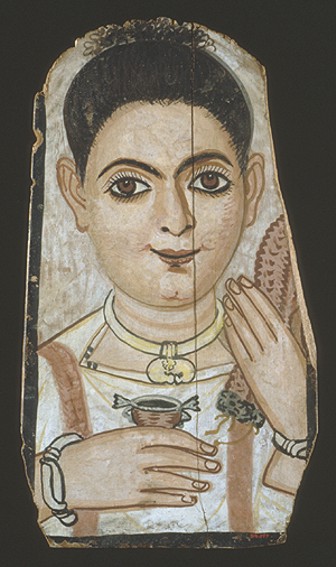
The people depicted in these paintings are Greeks and Romans as well as people of mixed Egyptian and Greek/Roman marriages. These people were the wealthy elite of Roman Egypt, as attested by the fact that they could afford lavish funerals, the common people could not afford mummies nor mummy portraits. Evidence seems to suggest that native Egyptians did not adopt the practice, simply because no Mummy Portraits of pureblood Blacks have so far surfaced, whether this is because there are none, or perhaps some other reason, is undetermined at this time.
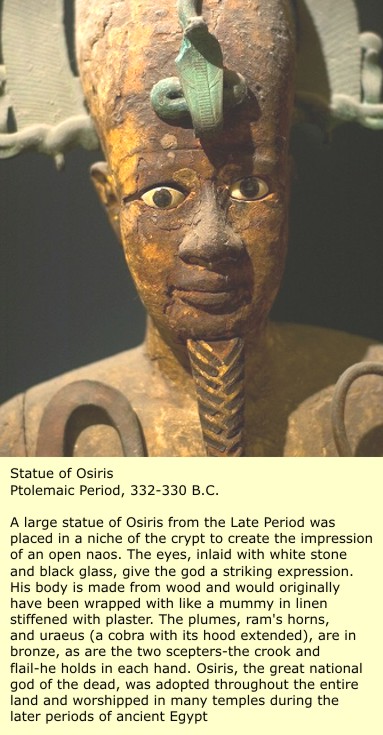
No comments:
Post a Comment